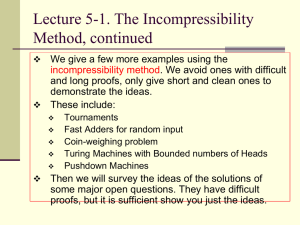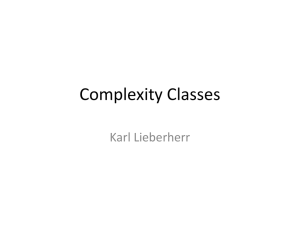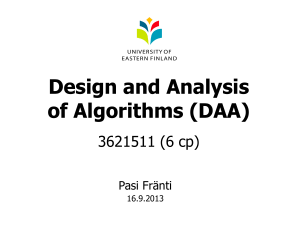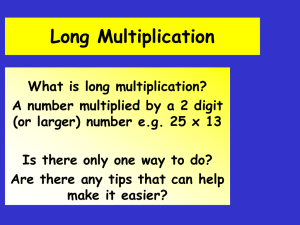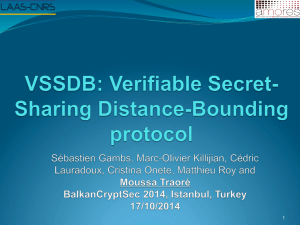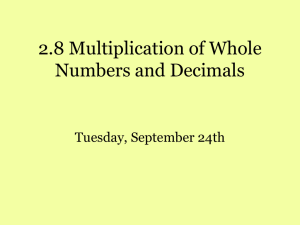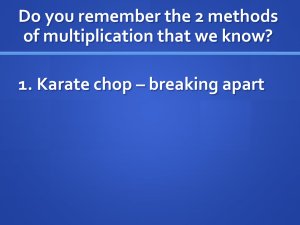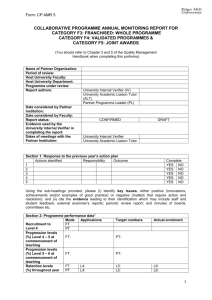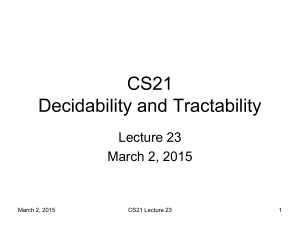Slides (.ppt)
advertisement
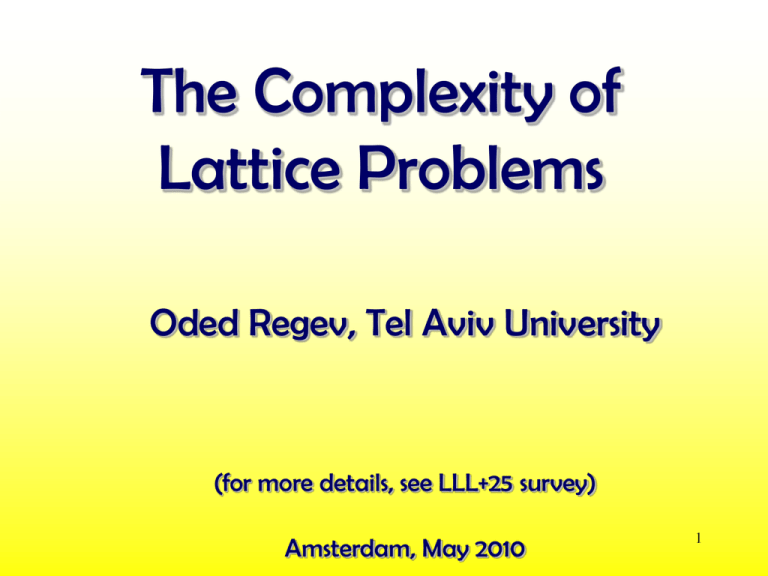
The Complexity of
Lattice Problems
Oded Regev, Tel Aviv University
(for more details, see LLL+25 survey)
Amsterdam, May 2010
1
Lattice
• For vectors v1,…,vn in Rn we define the
lattice generated by them as
L={a1v1+…+anvn | ai integers}
2v1 v1+v2
• We call v1,…,vn a basis of L
v1
v2
2v2
2v2-v1
2v2-2v1
0
Lattices from a Computational Complexity
Point of View
• Lattice problems are among the richest problems
in complexity theory, exhibiting a wide range of
behaviors:
– Some problems are in P (as shown by LLL)
– Some problems are NP-hard
– Some problems are not known to be in P, but believed
not to be NP-hard
• As a rule of thumb, ‘algebraic’ problems are easy;
‘geometric’ problems are hard
3
Shortest Vector Problem (SVP)
v2
v1
0
• GapSVP: Given a lattice, decide if the length of the
shortest vector is:
– YES: less than 1
– NO: more than
4
Closest Vector Problem (CVP)
v
v2
v1
0
• GapCVP: Given a lattice and a point v, decide if the distance of v
from the lattice is:
– YES: less than 1
– NO: more than
• GapSVP is not harder than GapCVP [GoldreichMicciancioSafraSeifert99]
• Both problems are clearly in NP (for any )
5
Known Results
• Polytime algorithms for gap 2n loglogn/logn
[LLL82,Schnorr87,AjtaiKumarSivakumar02]
• Hardness is known for:
– GapCVP: nc/loglogn [vanEmdeBoas81…,DinurKindlerRazSafra03]
– GapSVP: 1 in l1 [vanEmdeBoas81] 1 [Ajtai96]
2 [Micciancio98] 2^(log½-εn) [Khot04]
nc/loglogn [HavivR07]
1
nc/loglogn
NP-hard
?n
Cryptography
[Ajtai96,AjtaiDwork97…]
2n loglogn/logn
P
Known Results
Limits on Inapproximability
• GapCVPn 2 NP∩coNP [LagariasLenstraSchnorr90,
Banaszczyk93]
• GapCVPn/logn 2 NP∩coAM [GoldreichGoldwasser98]
• GapCVPn 2 NP∩coNP [AharonovRegev04]
1
nc/loglogn
NP-hard
n
NP∩coAM
NP∩coNP
n
NP∩coNP
2n loglogn/logn
P
What’s ahead?
1. GapCVPn/logn 2 NP∩coAM [GoldreichGoldwasser98]
2. GapCVPn 2 NP∩coNP [AharonovRegev04]
8
What’s ahead?
1. GapCVPn/logn 2
2. GapCVPn 2
coAM [GoldreichGoldwasser98]
coNP [AharonovRegev04]
9
Chapter I
GapCVPn in coAM
[GoldreichGoldwasser98]
10
Our Goal
Given:
- Lattice L (specified by a basis)
- Point v
We want to:
Be convinced that v is far from L by interacting
with an (all powerful) prover (using a constant
number of rounds)
11
The Idea
12
Basic High-dimensional Geometry
• How big is the intersection of two balls of radius 1
in n dimensions whose centers are at distance
apart?
– When 2, balls disjoint
– When =0, balls exactly overlap
– When =0.1, intersection is exponentially small
– When =1/n, intersection is constant fraction
13
The Protocol
•
Flip a fair coin
– If heads, choose a random point in L+B
– If tails, choose a random point in L+B+v
•
•
Send the resulting point to the prover
The prover is supposed to tell whether the
coin was heads of tails
(Can be implemented efficiently)
14
Demonstration of Protocol
15
Demonstration of Protocol
16
Analysis
• If dist(v,L)>2 then prover can always answer
correctly
• If dist(v,L)<1/n then with some constant
probability, the prover has no way to tell what
the coin outcome was
– Hence we catch the prover cheating with some
constant probability
• This completes the proof
17
Chapter II
GapCVPn in coNP
[AharonovR04]
18
Our Goal
Given:
- Lattice L (specified by a basis)
- Point v
We want:
A witness for the fact that v is far from L
19
Overview
Step 1: Define f
Its value depends on the distance from L:
– Almost zero if distance > n
– More than zero if distance < log n
Step 2: Encode f
Show that the function f has a short description
Step 3: Verifier
Construct the NP verifier
20
Step 1:
Define f
21
The function f
Consider the Gaussian:
Periodize over L:
( x) e
g ( x) ( L x) e
Normalize by g(0):
f ( x)
x
x y
yL
g ( x)
g (0)
22
2
2
The function f (pictorially)
23
f distinguishes between far and close
vectors
(a) d(x,L)≥n
(b) d(x,L)≤logn
f(x)≤2-Ω(n)
f(x)>n-5
Proof: (a) [Banaszczyk93]
(b) Not too difficult
24
Step 2:
Encode f
25
The function f (again)
g ( x) e
x y
2
yL
f ( x)
g ( x)
g ( 0)
Let’s consider its Fourier transform !
26
f̂
is a probability distribution
Claim: f̂ : L*R+ is a probability
distribution on L*
L* w | w, x Z
g is a convolution of a Gaussian and δL
Proof:
gˆ ( w) e
x L
x
fˆ ( w)
2
e
ˆL
0
gˆ ( w )
g (0)
w
e
2
w L*
o.w.
w 2
e
zL*
z 2
27
f as an expectation
f ( x)
wL*
ˆf ( w)e 2i x , w
Ew fˆ [e
2i x , w
]
In fact, it is an expectation of
a real variable between -1 and 1:
f ( x) Ew fˆ [cos(2 x, w )]
28
Encoding f
f ( x) Ew fˆ [cos(2 x, w )]
Pick W=(w1,w2,…,wN) with N=poly(n)
according to the f̂ distribution on L*
fW ( x )
N
1
N
cos(2 x, w )
j 1
j
f ( x ) fW ( x )
(Chernoff)
This is true even pointwise!
29
The Approximating Function
fW ( x )
N
1
N
cos(2 x, w )
j 1
j
(with N=1000 dual vectors)
30
Interlude: CVPP
GapCVPP
Solve GapCVP on a preprocessed lattice (allowed infinite
computational power, but before seeing v)
(ideas led to [MicciancioVoulgaris10]’s recent deterministic 2n
algorithm for lattice problems)
Algorithm for GapCVPP:
Prepare the function fW in advance;
When given v, calculate fW(v).
Algorithm for GapCVPP(n/logn) (best known!)
31
This concludes Step 2: Encode f
The encoding is a list W of vectors in L*
fW(x) ≈ f(x)
32
Step 3:
NP Verifier
33
The Verifier (First Attempt)
Given input L,v, and witness W, accept iff
1. fW (v) < n-10, and
2. fW(x) > n-5 for all x within distance logn from L
• This verifier is correct
• But: how to check (2) efficiently?
- First check that fW is periodic over L (true if W in L*)
- Then check that >n-5 around origin
• We don’t know how to do this for distance logn
• Instead, we do this for distance 0.01
34
The Verifier (Second Attempt)
Given input L,v, and witness W, accept iff
1. fW (v) < n-10, and
2. w1,…,wN L*, and
2
fW ( x )
3.
n
x , u ,
100
2
xu
2 implies that fW is periodic on L:
x n , y L, fW ( x y )
N
1
N
N
1
N
cos(2 x y, w )
j
j 1
cos(2 x, w 2 y, w ) f
j 1
j
j
W
(x)
35
The Verifier (Second Attempt)
Given input L,v, and witness W, accept iff
1. fW (v) < n-10, and
2. w1,…,wN L*, and
2
fW ( x )
3.
n
x , u ,
100
2
xu
1.2
3 implies that fW is at least 0.8 within
distance 0.01 of the origin:
1
fW (0) 1
fW
(0) 0
xu
fW(x)
0.8
0.6
0.4
0.2
0
-0.2
-.01
0
.01
36
The Final Verifier
Given input L,v, and witness W, accept iff
1. fW (v) < n-10, and
2. w1,…,wN L*, and
3.
||WWT||<N where W w1 w2 ....... wN
3 checks that in any direction the w’s are not too long:
N
WW T max u 1 uWW T u T max u 1 u , w j 2
j 1
37
The Final Verifier
Given input L,v, and witness W, accept iff
1. fW (v) < n-10, and
2. w1,…,wN L*, and
3.
||WWT||<N where W w1 w2 ....... wN
2 fW ( x) 4 2
2
xu
N
2 fW ( x) 4 2
2
xu
N
N
w , u
j 1
j
2
cos(2 w j , x )
2
2
4
4
2
T T
T
w
,
u
uWW
u
WW
100
j
N
N
j 1
N
38
Conclusion and Open Questions
• Lattice problems with approximation factors
>n are unlikely to be NP-hard
– These are the problems used for crypto
– Can we say anything about their hardness?
• Perhaps relate to hardness of other problems, say
factoring?
• Extremely important question for crypto
• Can the containment in NP∩coNP be
improved to (n/logn) or even below?
41
Thanks!
42
